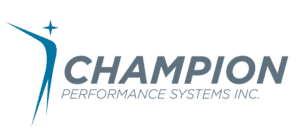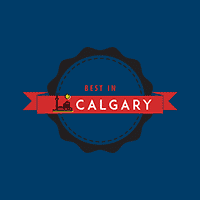It’s an exciting time when your business is on the cusp of rapid growth. Scaling up an organization is not only exhilarating— it can also be a major challenge.
However, if you navigate the growth process with the right tools, your business will emerge more substantial and unshakeable than before. So, where should you start? This article will cover the most popular business methods for scaling up that can put you on the path success, including:
- The Rockefeller Habits™
- Scaling Up™
- Entrepreneurial Operating System (EOS)
- Objectives and Key Results (OKRs)
These four methodologies are covered in Peter Drucker’s Management by Objectives. Management by Objectives lays out a management model that seeks to improve business by creating clearly defined objectives. These objectives should be shared both by management and employees. Essentially, Drucker argues that goal-setting and action plans are the foundation for increased employee participation and commitment.
These core concepts have since been expanded on by the creators of Rockefeller Habits, Scaling Up, Entrepreneurial Operating System, and Objectives and Key Results, respectively. Each methodology offers a unique focus, and all four come with their own pros and cons. As such, any might provide a superior fit depending on the business that is using them during the growth process.
The Rockefeller Habits™
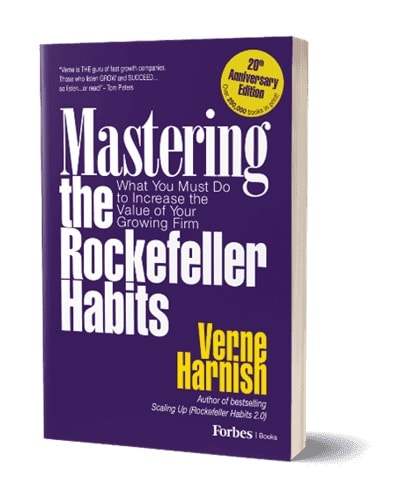
The concept of Rockefeller Habits — also expounded on in Scaling Up — was created by Verne Harnish. Harnish is the author of Mastering the Rockefeller Habits and Scaling Up as well as the founder of the Entrepreneur’s Organization.
The Rockefeller Habits strategy is derived from its namesake, the Rockefeller of Standard Oil fame, and it has been put into practice by companies around the world. The strategy is rooted in Rockefeller’s famous 10 habits, which are:
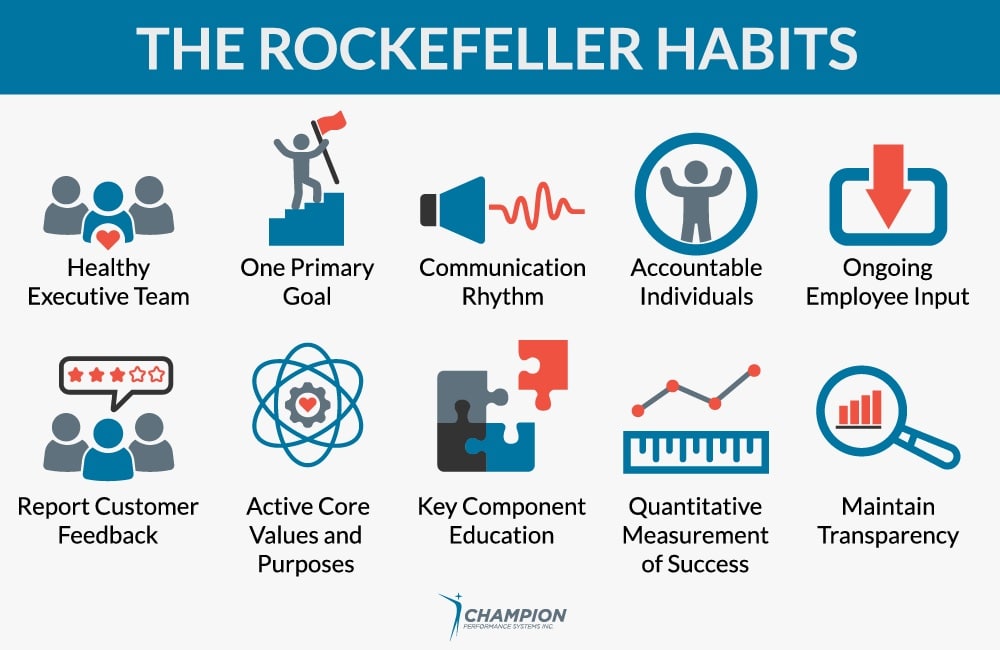
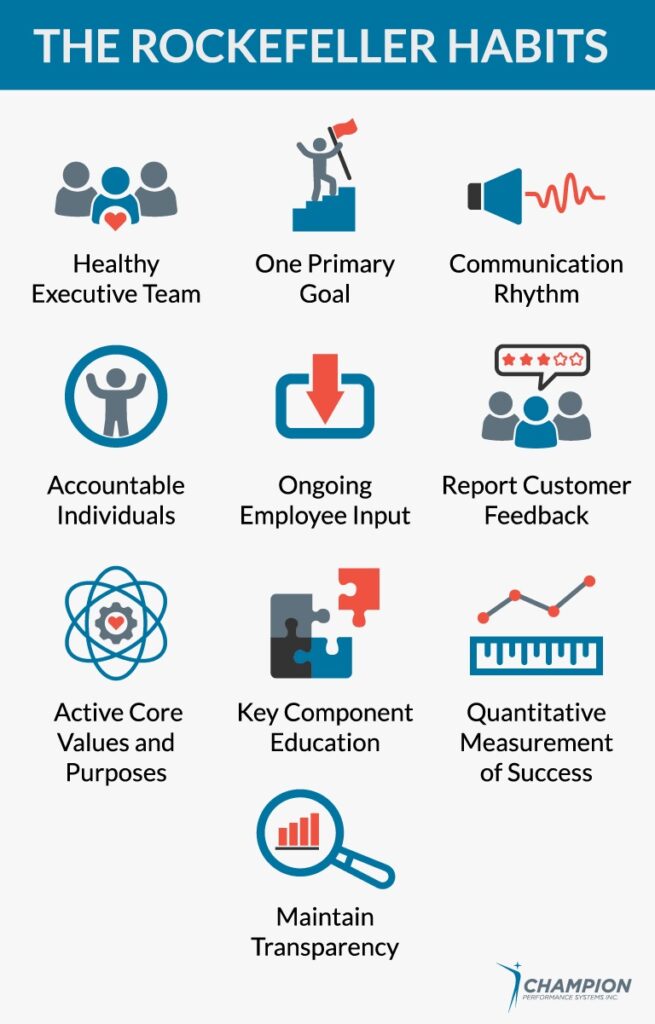
- Aligning and caring for the health of the executive team
- Focusing on one primary goal per quarter that is necessary for growth
- Developing a rhythm of communication that is quick and efficient
- Assigning a person to be accountable for the goals of each individual facet of the organization
- Collecting ongoing employee input to foster growth and avoid obstacles
- Reporting regularly on customer feedback
- Developing healthy core values and purposes
- Educating employees about the key components of the company’s strategy
- Building a company-wide understanding of how to quantitatively measure daily and weekly success
- Maintaining transparency in the company’s plans and performance
Harnish argues that by following a list like this one, businesses can more easily navigate the complex issues that often slow down growth and progress.
Scaling Up™
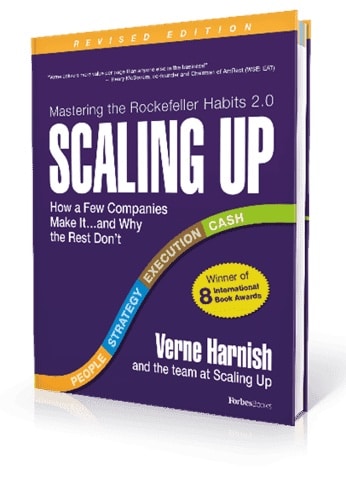
Scaling Up expands on many of the concepts discussed in Mastering the Rockefeller Habits. Essentially, Harnish’s methodology of Scaling Up focuses on building a cohesive company culture. Harnish writes, “If the core values are the soul of the organization, the core purpose (some call it “mission”) gives it heart.”
What is the heart of your business? What drives you and your team forward? If you cannot clearly answer these questions, Harnish argues that your business’s growth will be severely stifled. Among many other guidelines, he recommends the practice of a daily huddle as a means of strengthening communication and goal-setting.
Another central concept is the development of a unifying strategic vision and core values. The cornerstone of this idea is Harnish’s One-Page Strategic Plan. This one-page growth tool is meant to help businesses approach growing their business values in an actionable way. The framework is developed around a system of quarterly goal-creating and monitoring with an eye on long-term growth.
Designed for businesses big and small, the Scaling Up methodology is truly meant for companies who are seeking to use change management to spark rapid growth. Harnish argues that by strengthening a business’s purpose, you can enhance the entire organization. Though there is an emphasis on purpose and drive, Scaling Up also addresses cash management, meeting techniques, and strategy at the highest level.
Scaling Up can be broken down into four areas of focus:
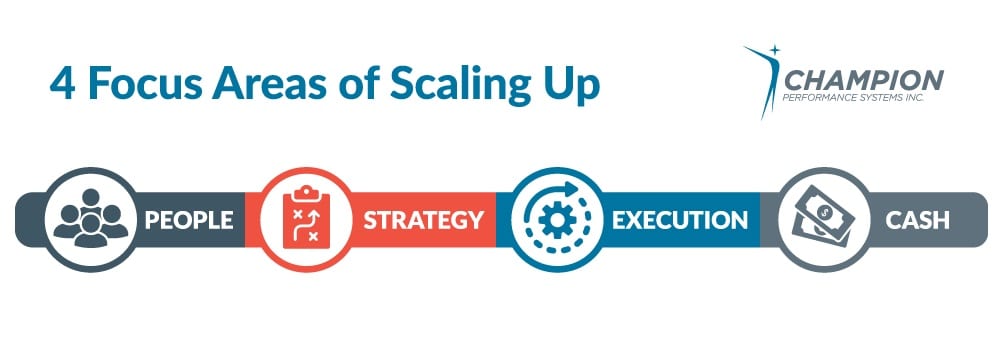
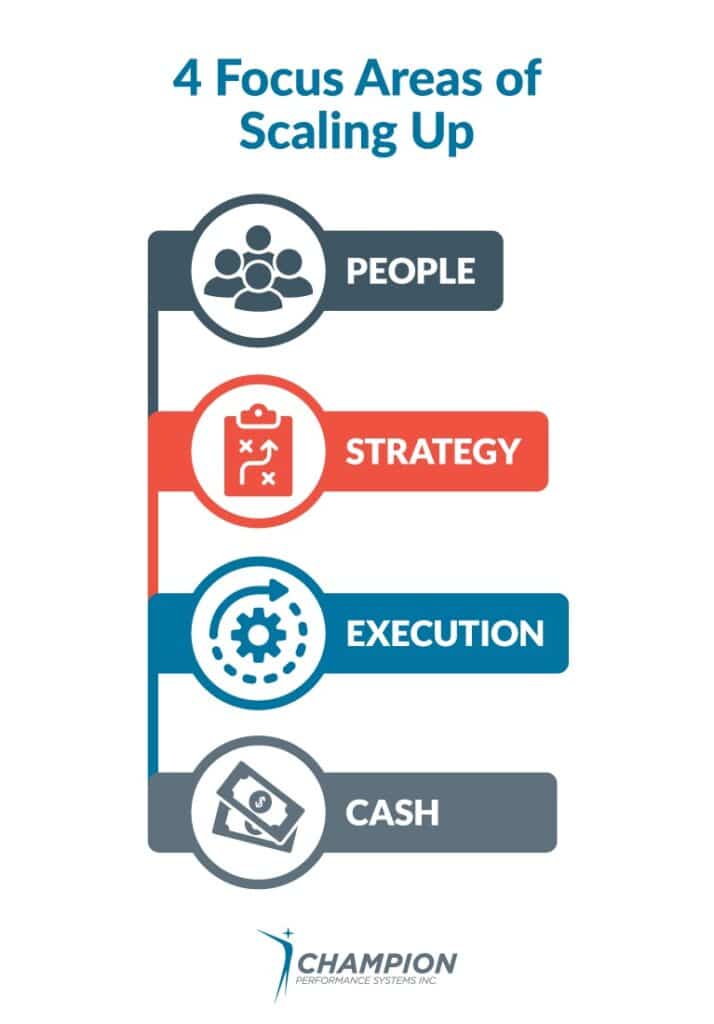
People
Harnish argues that people can either provide a positive source of energy for your business or be a negative emotional drain. Challenging relationships can arise in the form of tense partnerships, imbalanced customer relationships, or disruptive employees.
He suggests focusing on people-related issues you may have in your business to free up energy and resources to tackle other decisions. Your emphasis should be on choosing the right people for the right roles and setting them up for success with clear responsibilities.
Strategy
If your business is not growing at a desirable speed, Harnish recommends reevaluating your strategy. He argues that it is important to create a crystal clear summary of your strategy. This summary should be used to align the company’s goals and methods to avoid wasting time and resources. If a strategy isn’t yielding results, it should be overhauled per Scaling Up’s ideology.
Execution
Execution may be the source of the problem if you are struggling to increase profits alongside growing revenues. Essentially, Harnish describes effective execution as the streamlining of your business processes. By “tightening up” your execution, he asserts that your margins and profitability will thrive.
Cash
When it comes to cash, Harnish’s strategy revolves around determining the time it takes you to earn back every dollar that is spent. The Cash Conversion Cycle should be as short as possible so that your business has the cash flow to support impending growth.
EOS: Entrepreneurial Operating System
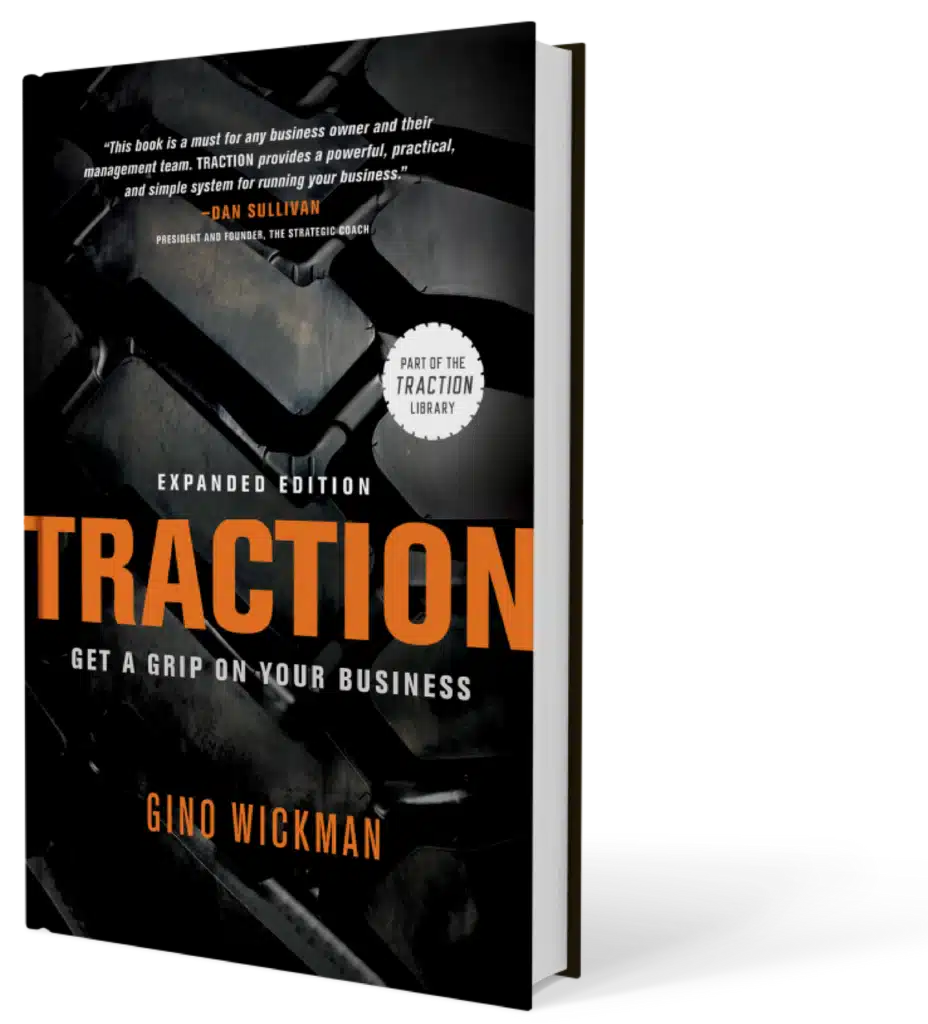
The Entrepreneurial Operating System, or EOS, is the brainchild of Gino Wickman. Wickman wrote Traction: Get a Grip on Your Business. Gino is a long-time follower of Harnish and the Entrepreneur’s Organization, which is clear in EOS’s many similarities to Scaling Up.
Ultimately, EOS distills the Scaling Up methodology to its core, with an intense focus on people and execution. EOS also borrows from Stephen Covey’s concept of Big Rocks, which he outlines in his book, First Things First. A combination of the two strategies has resulted in a specific set of goals that must be completed every quarter. It involves six key elements of business:
- Vision. Vision should answer the eight questions of EOS and be shared unanimously across the company.
- People. Emphasis should be placed on ensuring that the right people are set up for success in the right roles
- Data. In this model, data should be tracked with measurables and discussed during weekly meetings.
- Issues. Issues are addressed in weekly meetings.
- Process. Documenting all processes thoroughly and promoting them universally throughout the business is essential.
- Traction. Traction involves creating a space for accountability, discipline, and focus. These qualities should be upheld so that every team member works toward the collective company vision every day.
Another core concept of EOS is the Level 10 Meeting. This strategy focuses on problem-solving and prioritizing issues. Level 10 Meetings follow a strict agenda designed to tackle important challenges. The 90-minute itinerary — intended for Monday mornings — typically includes:
Five-Minute Check-In
Level 10 Meetings start with a personal check-in. This element provides an opportunity for the team to launch the week on a positive note by sharing an accomplishment, epiphany, or anecdote.
Five-Minute Scorecard
The scorecard portion of the meeting is an opportunity to discuss pressing company metrics. Wickman suggests using the beach test — a creative way to measure the importance of an issue. If you would fly home from a lovely beach vacation to fix the problem, it passes the beach test and should be explored during the scorecard.
Five-Minute Rock Update
The Rock update is the time for the team to discuss company and department-wide Rocks — the quarterly goals and projects outlined in EOS. In a Rock update, the team should evaluate the progress of their projects. This update is the perfect opportunity to explore pressing issues in specific Rocks.
Five-Minute Employee and Client Headlines
Feedback is an important aspect of EOS. Take five minutes during the headlines section of the meeting to share client or employee feedback. Depending on the feedback, this exercise can serve as a morale-booster or learning experience for your team members.
Five-Minute To-Do List
A to-do list is a must-have productivity tool. In Level 10 Meetings, the to-do list should be a running document. Every week, note what has been completed, what is in progress, and what needs to be launched. Any issues that arise in this section should be added to discussions later in the meeting.
60-Minute Identify, Discuss, Solve
Identify, discuss, solve — or IDS — is the heart of a Level 10 Meeting. As a methodology, EOS is laser-focused on unpacking the roots of problems and solving them constructively. IDS is the concept of effective problem-solving in action.
Wickman recommends tracking all discussions in a running document using software like Google Sheets. Team members who are present at the meeting vote on their top three priorities and analyze them during the session. To keep the rhythm of the meetings moving organically, repetitive issues can be tabled for a longer quarterly discussion.
Five-Minute Wrap-Up
The wrap-up is your opportunity to recap the items on your to-do list and remind the team about the next steps from the meeting.
The simplicity of EOS makes it a great fit for small to medium-sized enterprises, or SMEs. The advantage of the strategy lies in its ease of implementation and accelerated timeline.
While the methods of Scaling Up can take multiple quarters to enact, you can realistically implement change with the EOS system over the course of one quarter. Tools like the Level 10 Meeting can even be adopted as a supplement to more comprehensive systems like Rockefeller’s Habits and Scaling Up.
OKR: Objectives and Key Results
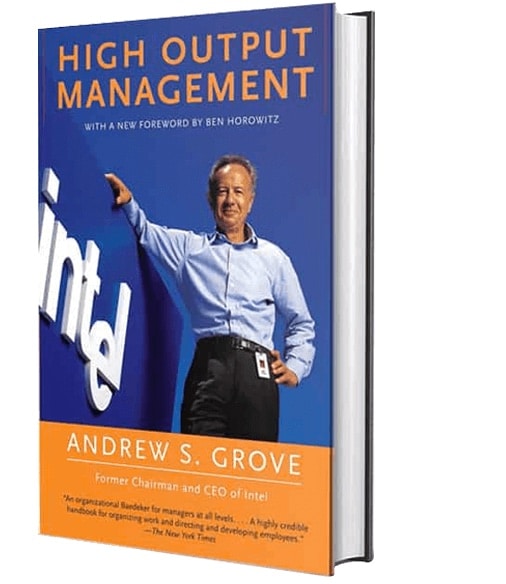
Objective and Key Results, also known as OKRs, were born from concepts in Andy Grove’s High Output Management and later reiterated in John Doerr’s Measure What Matters. OKRs have been made famous by Silicon Valley giants like Intel and Google, which use them to manage goals.
Objectives and Key Results are collaborative goal-setting tools. They can be used by either teams or individuals seeking to set actionable goals with measurable results. OKRs empower businesses to monitor progress, develop company-wide alignment, and inspire engagement around business goals.
OKRs are flexible and can be applied to a wide range of verticals. They can even be put into practice by individuals who have personal aspirations or are looking for more structure within their work lives. As suggested by the name, Objectives and Key Results focus on two primary concepts:
Objectives
An objective can be defined as what you want to achieve. According to Grove, objectives should be:
- Significant
- Concrete
- Actionable
- Inspirational
Objectives are an antidote against murky ideas and half-baked plans. The goal is for every element of OKRs to be tangible and measurable.
Key Results
Key Results are milestones on the path to achieving an objective. They often include Key Progress Indicators. In alignment with the concrete quality of OKRs, Key Results should be:
- Specific
- Set within a defined time limit
- Ambitious
- Realistic
- Measurable
- Verifiable
KRs rely on clarity — you either accomplish the requirements of your Key Result or you don’t. In the OKR methodology, you will check in on your Key Results every quarter. In theory, when your Key Results are achieved, you should reach your Objective.
Using OKRs
The quantitative nature of OKRs makes this methodology simple and effective. Of the prevalent methodologies, OKRs are the most flexible and can be adopted by a massive range of professionals. When it comes to scaling up, however, this strategy may lack the nuances needed to spark rapid growth in a short period of time compared to EOS, Scaling Up, and Rockefeller Habits.
Comparing The Rockefeller Habits, Scaling Up, EOS, and OKRs
When comparing the four methodologies — Rockefeller Habits, Scaling Up, EOS, and OKRs — it quickly becomes clear that they all share ideologies, tools, and even thought leaders.
Goal-setting and tracking are essential, but the methodology you choose is up to you. Many organizations decide to combine methods to meet the unique goals of their business.
For example, Scaling Up and EOS are best suited for companies looking for specific, day-to-day tactics. For added power, you may use Scaling Up’s Daily Huddle concept in tandem with the weekly Level 10 leadership meetings of EOS. Consider tailoring your choice to match the distinct scope of your leadership goals.
Consider the way The Rockefeller Habits and Scaling Up place a heavy emphasis on the people involved in your business. EOS addresses this to a degree as well by leaning on team member interactions in its Level 10 Meetings. OKRs, though, place little emphasis on people. Depending on your company, consider where your current strengths and weaknesses lie. Are you looking for a new way to conduct meetings? If yes, the former three methodologies provide a wealth of meeting tactics. If no, OKRs provide a more simple mode of organizational change.
At the end of the day, there are key differences that might appeal to different businesses in different industries. These differences can be found in seven specific areas.
1. Strategic Vision
Developing and articulating a strategic vision is a strong suit of both The Rockefeller Habits and Scaling Up, which feature the One-Page Strategic Plan and a focus on core values.
While OKRs don’t offer any tools in this area, EOS utilizes a comprehensive Vision and Traction Organizer meant to help businesses articulate and monitor their goals.
2. Priorities
All four of the methodologies discussed have a framework that highlights business-wide priorities.
In Scaling Up, The Rockefeller Habits, and EOS, the concept of Big Rocks creates a cyclical structure for evaluating and organizing your company priorities in a meaningful way. EOS demonstrates its emphasis on priorities in the Level 10 Meeting. Each agenda item in the Level 10 Meeting asks participants to prioritize action items and issues.
On the other hand, Objectives and Key Results are literally centered around the concept of priorities. In this instance, Objectives act as a synonym for priorities. Key Results offer a quantitative way to track the progress of your priorities over time.
3. Meeting Milestones
Both The Rockefeller Habits and Scaling Up provide various methods for measuring the way your business meets milestones. These are mostly discussed in terms of key metrics and day-to-day financial techniques.
EOS addresses milestones most directly in the Scorecard portion of its Level 10 Meetings. EOS also provides space for businesses to celebrate their milestones along the way.
OKRs are perhaps the most direct in prioritizing milestones, which are tracked as Key Results or Key Progress Indicators. Milestones are often easiest to track when they are strictly quantitative.
4. Meeting Structure
Verne Harnish’s methods offer guidelines on meeting structures on both a day-to-day and long-term level. Within The Rockefeller Habits and Scaling Up, Harnish recommends tools such as:
- Daily huddles
- Weekly team meetings
- Monthly meetings with management
- Quarterly planning sessions
- Annual planning sessions
In EOS, the meeting structure gets broken down to a granular level with the concept of the Level 10 Meeting. With a minute-by-minute agenda, EOS provides the clearest picture of what a scaling business’s meetings should look like.
5. Self-Assessment
The Rockefeller Habits and its successor, Scaling Up, both feature the Rockefeller Checklist. This serves as a powerful self-assessment tool for growing organizations.
Though OKRs are grounded in self-awareness, EOS offers the stronger assessment tool in the form of the multiple rounds of organizational check-ins that are built into Level 10 Meetings.
6. Core Values
Scaling Up and The Rockefeller Habits undoubtedly lead the pack when it comes to core values. Harnish’s guiding concepts stem from the importance of core values and purpose in a company. EOS borrows the concept in its methodology.
7. Accountability
While OKRs don’t offer much in the way of accountability tools, both of Harnish’s concepts as well as EOS offer a valuable tool known as an Accountability Chart. The tool is meant to ensure that no facet of a business slips through the cracks without a caretaker.
The Bottom Line

As you delve deeper into the methodologies of scaling your business, it becomes clearer that, though the modes of action differ slightly, they fundamentally share the same focus. Ultimately, all four concepts seek to:
- Develop a concrete plan
- Align a business from top to bottom
- Meet tangible, quantitative goals within a time limit
If your business is ready to scale up, it is important to choose a methodology that not only aligns with your values but will also put you on the path to your long-term goals. Fortunately, there is a wealth of knowledge and tools that can help you grow your business the right way.
No matter which methodology you choose, Champion PSI’s strategic planning and execution training services can help you gain more insight into the future of your business.
Champion’s services help you create a valuable connection between your strategy and your execution. Escape the pitfall of creating idealistic but ultimately empty strategies. Instead, let Champion PSI guide you through the process of scaling up through tangible strategic planning. Training includes:
The One-Page Strategic Plan
As made famous by Verne Harnish’s Scaling Up, Champion PSI can help you understand the future of your business strategy execution through their enhanced one-page strategic plan process. Throughout the process, Champion PSI incorporates and utilizes advanced resources, exercises, tools, and assessment systems that are present in Harnish’s key concepts. With the One-Page Strategic Plan, you will distill your core values into an indispensable document.
Goal Definition
Champion PSI helps guide your progress through thorough research and performance analysis. A custom approach is best, which is why Champion PSI will help train your business leaders how to both create a strategic plan and implement, optimize, and execute it successfully.
Customized Help
Templates are valuable, but Champion PSI believes that customization leads to expedited and more meaningful results. With their strategic planning and execution training services, Champion PSI meets and exceeds the unique goals of your distinct company.
Ken’s experience is with organizations millions, to billions—with top line revenue. To learn more, schedule a 30-minute meeting today.
